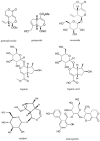The Impact of Anthocyanins and Iridoids on Transcription Factors Crucial for Lipid and Cholesterol Homeostasis
- PMID: 34199904
- PMCID: PMC8200123
- DOI: 10.3390/ijms22116074
The Impact of Anthocyanins and Iridoids on Transcription Factors Crucial for Lipid and Cholesterol Homeostasis
Abstract
Nutrition determines our health, both directly and indirectly. Consumed foods affect the functioning of individual organs as well as entire systems, e.g., the cardiovascular system. There are many different diets, but universal guidelines for proper nutrition are provided in the WHO healthy eating pyramid. According to the latest version, plant products should form the basis of our diet. Many groups of plant compounds with a beneficial effect on human health have been described. Such groups include anthocyanins and iridoids, for which it has been proven that their consumption may lead to, inter alia, antioxidant, cholesterol and lipid-lowering, anti-obesity and anti-diabetic effects. Transcription factors directly affect a number of parameters of cell functions and cellular metabolism. In the context of lipid and cholesterol metabolism, five particularly important transcription factors can be distinguished: liver X receptor (LXR), peroxisome proliferator-activated receptor-α (PPAR-α), peroxisome proliferator-activated receptor-γ (PPAR-γ), CCAAT/enhancer binding protein α (C/EBPα) and sterol regulatory element-binding protein 1c (SREBP-1c). Both anthocyanins and iridoids may alter the expression of these transcription factors. The aim of this review is to collect and systematize knowledge about the impact of anthocyanins and iridoids on transcription factors crucial for lipid and cholesterol homeostasis.
Keywords: anthocyanins; cholesterol; iridoids; lipids; transcription factors.
Conflict of interest statement
The authors declare no conflict of interest.
Figures
Similar articles
-
Cornelian Cherry (Cornus mas L.) Fruit Extract Lowers SREBP-1c and C/EBPα in Liver and Alters Various PPAR-α, PPAR-γ, LXR-α Target Genes in Cholesterol-Rich Diet Rabbit Model.Int J Mol Sci. 2024 Jan 18;25(2):1199. doi: 10.3390/ijms25021199. Int J Mol Sci. 2024. PMID: 38256272 Free PMC article.
-
Cornelian Cherry (Cornus mas L.) Iridoid and Anthocyanin Extract Enhances PPAR-α, PPAR-γ Expression and Reduces I/M Ratio in Aorta, Increases LXR-α Expression and Alters Adipokines and Triglycerides Levels in Cholesterol-Rich Diet Rabbit Model.Nutrients. 2021 Oct 16;13(10):3621. doi: 10.3390/nu13103621. Nutrients. 2021. PMID: 34684622 Free PMC article.
-
The Effects of Natural Iridoids and Anthocyanins on Selected Parameters of Liver and Cardiovascular System Functions.Oxid Med Cell Longev. 2020 Mar 31;2020:2735790. doi: 10.1155/2020/2735790. eCollection 2020. Oxid Med Cell Longev. 2020. PMID: 32318236 Free PMC article. Review.
-
Studies on the regulation of lipid metabolism and its mechanism of the iridoids rich fraction in Valeriana jatamansi Jones.Biomed Pharmacother. 2016 Dec;84:1891-1898. doi: 10.1016/j.biopha.2016.10.099. Epub 2016 Nov 8. Biomed Pharmacother. 2016. PMID: 27832992
-
SREBP transcription factors: master regulators of lipid homeostasis.Biochimie. 2004 Nov;86(11):839-48. doi: 10.1016/j.biochi.2004.09.018. Biochimie. 2004. PMID: 15589694 Review.
Cited by
-
Plant iridoids: Chemistry, dietary sources and potential health benefits.Food Chem X. 2025 Apr 23;27:102491. doi: 10.1016/j.fochx.2025.102491. eCollection 2025 Apr. Food Chem X. 2025. PMID: 40336984 Free PMC article. Review.
-
Dose-Related Regulatory Effect of Raspberry Polyphenolic Extract on Cecal Microbiota Activity, Lipid Metabolism and Inflammation in Rats Fed a Diet Rich in Saturated Fats.Nutrients. 2023 Jan 10;15(2):354. doi: 10.3390/nu15020354. Nutrients. 2023. PMID: 36678224 Free PMC article.
-
NMR, LC-MS Characterization of Rydingia michauxii Extracts, Identification of Natural Products Acting as Modulators of LDLR and PCSK9.Molecules. 2022 Mar 30;27(7):2256. doi: 10.3390/molecules27072256. Molecules. 2022. PMID: 35408655 Free PMC article.
-
Extract from Aronia melanocarpa, Lonicera caerulea, and Vaccinium myrtillus Improves near Visual Acuity in People with Presbyopia.Nutrients. 2024 Mar 23;16(7):926. doi: 10.3390/nu16070926. Nutrients. 2024. PMID: 38612968 Free PMC article. Clinical Trial.
-
Effect of dietary anthocyanins on the risk factors related to metabolic syndrome: A systematic review and meta-analysis.PLoS One. 2025 Feb 10;20(2):e0315504. doi: 10.1371/journal.pone.0315504. eCollection 2025. PLoS One. 2025. PMID: 39928643 Free PMC article.
References
Publication types
MeSH terms
Substances
LinkOut - more resources
Full Text Sources
Medical




